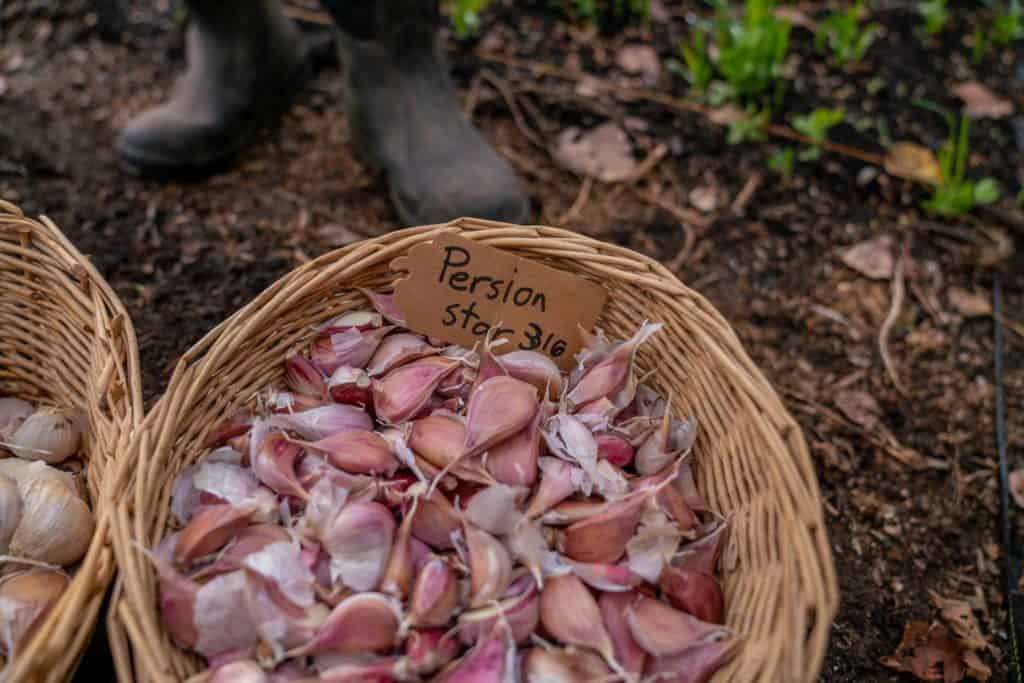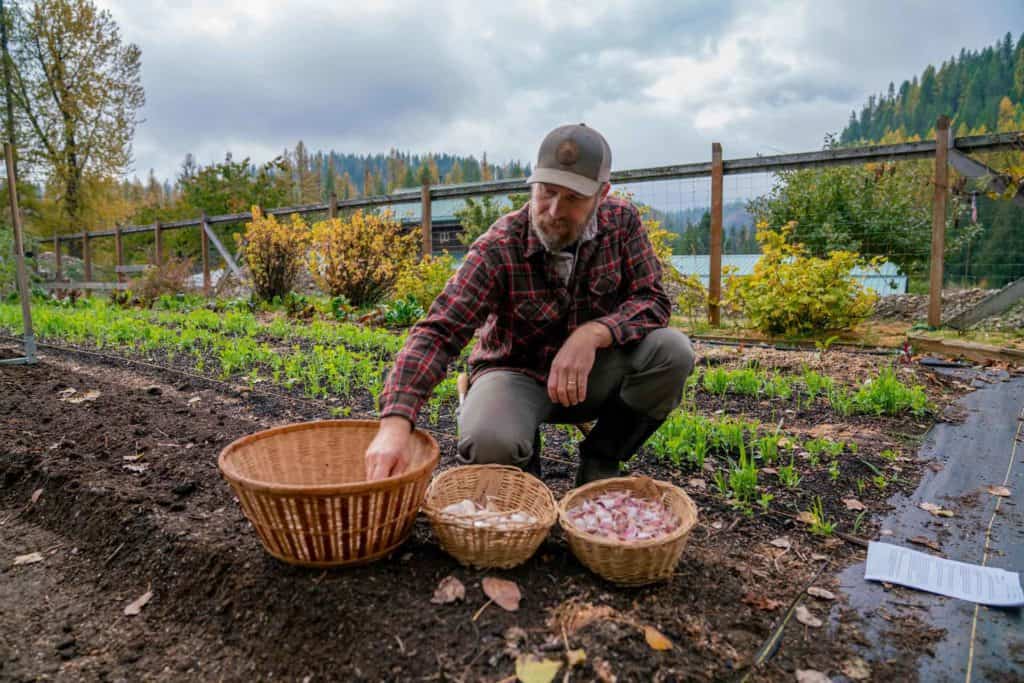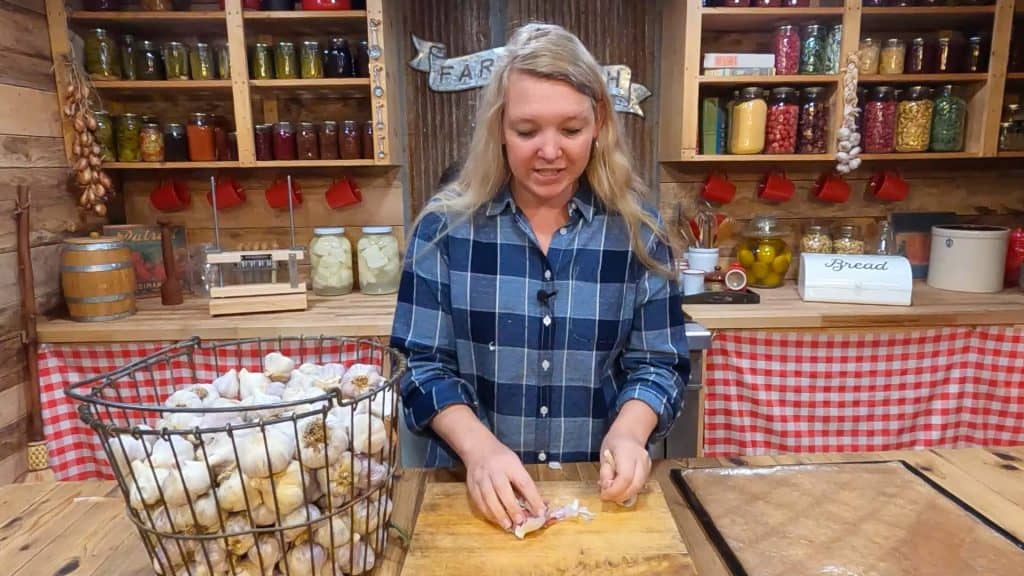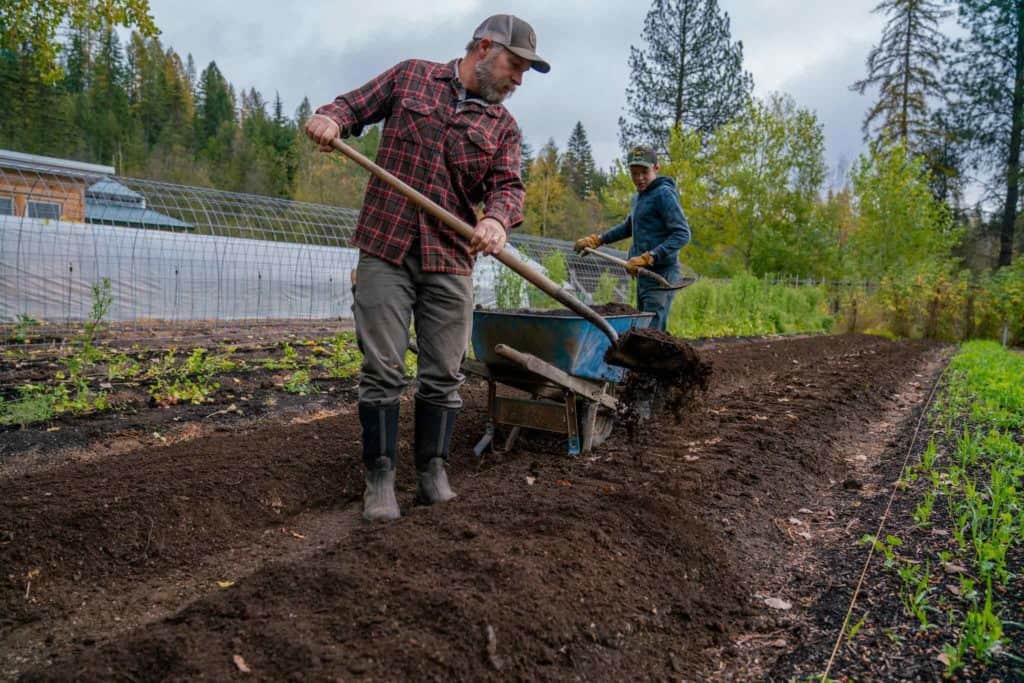From ancient times to now, garlic has held a high standing in many cultures worldwide with its amazing taste and medicinal benefits. You may love the taste of garlic, but the best motivation for growing garlic isn’t the taste! Plant a clove and enjoy the long-standing benefits of this medicinal bulb.

Much folklore revolves around garlic, like the ability to fight diseases, mosquitoes, vampires and warewolves. Midwives used to hang it in birthing rooms to ward off evil spirits, and warriors ate it to give them courage. Though we don’t believe in garlic’s mystical powers, we do know it packs a great medicinal punch for our herbal medicine cabinet which is why growing garlic is a mainstay in our garden every year.
Why I Love Growing Garlic
We LOVE garlic! We love the taste and its medicinal uses. Using herbs, fruits, and vegetables that we grow to promote our family’s health brings us joy and health security.
Our gardens help us to achieve independence in our healthcare. If you want to go “off-grid” with your health, we want to help you learn how to start using medicinal herbs.
Over the years, we learned how to use herbal medicine safely at home and developed our knowledge of medicinal herbs and their uses. We feel confident recommending these 15 medicinal herbs to grow, harvest and use for the beginner.
Garlic plays a significant role in our daily life. We use it in our cooking and our medicinal practices. Discover how to plant garlic (fall garlic planting), grow, harvest, store, preserve, and use it for its delicious flavor profile and incredible healing powers.
Varieties of Garlic
The different types of garlic fall into three main categories: hardneck, softneck, and elephant.

Hardneck
Hardneck garlic varieties grow well in cool climates and typically grow larger cloves with a robust and flavorful garlic taste. They produce garlic scapes in the spring that you can harvest and eat. They taste wonderful stir-fried!
You need to use hardneck varieties of garlic within 4-6 months of harvesting them. The cloves are easy to prepare and use as they tend to peel more easily than other varieties of garlic.
Some popular hardneck varieties include the following:
- Purple Glazer – This variety produces beautiful cloves of garlic with purple striping on the outer skins. It tastes wonderful, especially when baked or roasted. It grows well in cooler temperatures, ideally suited for zones 5-7. When planted in the fall, it grows garlic scapes that you can harvest and eat in the early summer.
- Metechi – This stunning garlic also produces a marbled purple stripe. It tastes spicy and robust. Some describe it as fiery hot when eaten raw. It matures mid to late season and stores well after harvesting due to its tight cloves, allowing it to last up to 6 months after harvest. You can grow this variety in about any climate, but it loves the cooler temperatures.
- Chesnok Red – This purple-striped variety tastes more sweet than spicy. It especially tastes great when roasted! This hardy and productive garlic grows well in the United States’ northern and southern regions.
- Spanish Roja – This purple-striped variety is a popular choice by culinary experts. It boasts a true garlic flavor that is both sweet and spicy. It peels easily and produces a delicious garlic scape in the spring.
- Siberian – This garlic loves cold climates. It boasts a nice spicy flavor that tastes sweet when cooked. High in allicin, it is the best medicinal garlic since allicin aids in normalizing cholesterol levels, increasing circulation, and strengthening the immune system. (Source)

Softneck
Softneck varieties of garlic grow well in warm climates and produce smaller cluster patterns with smaller cloves. These mild-flavored garlic cloves taste delicious and store well. They can outlast hardneck varieties by several months when stored correctly.
Some popular softneck varieties include the following:
- Silver White – This silver variety of garlic produces a beautiful white outer layer. It grows well in cool climates and stores for up to 12 months, making it an excellent choice for braiding (Learn how to braid garlic here, you braid them just as you would onions).
- Inchelium Red – This softneck variety won awards for being the best softneck garlic variety. It produces high yields and a delicious culinary flavor with a sweet, mild, but partially hot taste. This also makes a perfect garlic braid.
- Italian Loiacono – This garlic can adapt to grow in various climates. It produces fewer cloves per bulb, but each individual clove is large and more square-like.
- California Softneck – California softneck garlic, most commonly found in the grocery store, offers a delicious spicy flavor, beautiful white cloves, and a papery skin. They can store for a very long time. Homegrown California softneck tastes much better than its store-bought counterparts.
Elephant
Elephant garlic’s name deceives us as it really isn’t garlic. It grows much like garlic but tastes like an onion, leek, or shallot. Amazingly, it produces bulbs that can grow to one pound each with only a few cloves on each bulb. You may enjoy its mild flavor and impressive look.

Health Benefits of Garlic
It’s important to note that I am not a certified medical practitioner. This post is not intended to diagnose or treat but is for informational purposes only. Please contact your medical care professional before introducing new herbal remedies into your wellness routine.
There is a rich history of garlic’s amazing health benefits, which graces our history books over and over again.
Used as a primary medicine in Ancient China, Sumeria, Assyria, Greece, Rome, India, Tibet, Korea, Russia, and more, we find it often in ancient texts. Scientists even found garlic in King Tut’s Tomb. The Bible also mentions garlic, as well as other religious and historical texts!
Today, garlic prevails in herbal and home remedies. The medical world recognizes its health benefits and conducts studies to prove its capabilities.
So, why is garlic so great? It contains powerful antioxidants, antiviral, antifungal, anti-inflammatory, and antibiotic properties. (Source) It often gets compared to penicillin.
Packed with nutrients, Garlic contains essential vitamins, minerals, and enzymes like vitamin C, potassium, calcium, magnesium, manganese, vitamin B6, zinc, sulfur, iron, selenium, and more. (Source)
Uniquely, when you mince or chew garlic, it releases a compound called allicin. Allicin gives garlic its identifying taste and smell and shows the promising ability to improve heart health and fight cancer. (Source) Read on to see some of garlic’s incredible superpowers.
- Improves Heart Health – Research articles show garlic has a promising ability to expand your blood vessels, which helps your body regulate blood pressure. (Source) Researchers agree allicin in garlic potentially reduces bad cholesterol, improves circulation, and prevents blood clots. (Source)
- Improves Immune System – Eating raw or cooked garlic is known to boost your immune system, making you healthier overall. But, some say that heating garlic over 140°F reduces some health benefits. Homesteading Hack: Add garlic toward the end of your recipes instead of at the beginning to preserve garlic’s immune system-boosting powers.
- Cures Coughs and Colds – Garlic helps to improve the common cold and coughs. (Source) Anecdotally, some have found eating two cloves of raw garlic daily may shorten a cold. Or, you can try rubbing garlic oil on your chest to help relieve a cough.
- Regulates Blood Sugar – Garlic may be helpful in balancing and regulating blood sugar when consumed regularly. (Source)
- Supports Brain Health – According to Dr. Axe, antioxidants in garlic, along with its anti-inflammatory properties, have been known to fight against brain diseases like dementia and Alzheimers.
- Fights Cancer – The allicin in garlic is linked to reducing the risk of lung, colon, and gastric cancer and is named among onions and leafy greens as a cancer-fighting food. (Source)
- Anti-inflammatory – Garlic has a natural anti-inflammatory effect, and rubbing sore joints or muscles with garlic oil could potentially bring healing and relief. (Source) Eating raw garlic has also been known to improve the inflammation in your stomach, improving gut health.
- Anti-fungal – Garlic contains anti-fungal properties that can fight against certain bacteria leading to fungal infections. You can use garlic to aid in clearing up fungal infections, like Athlete’s Foot, for example. (Source)
- Antibacterial, Antiviral, and Antiseptic – Garlic is an antiviral herb traditionally used to treat infectious diseases. (Source) Garlic also contains antibacterial properties that can internally and topically clear up bacterial infections. For example, you can rub garlic on acne, which fights the bacteria that lead to acne. But be careful; garlic can also sting sensitive skin. Try it topically a little at a time. When taken internally, garlic may reduce bacterial infections, internal parasites, and some viruses. (Source)

Culinary Ways to Enjoy Garlic
We love to use our homegrown garlic in various recipes in our kitchen. Aside from using it fresh almost daily, we enjoy making this pickled garlic and this homemade garlic salt.
Once we have garlic on hand, we can add it to just about any recipe. Garlic is a key ingredient in tomato sauce, especially my fermented tomato sauce. We add it to fermented ketchup, lacto-fermented mayo, and our homemade vinaigrette dressing.
Chopped garlic added to olive oil with Italian spices makes a delicious dip for my easy no-knead artisan bread, or just add garlic to the bread before baking or sprinkle with garlic salt.
Garlic also makes pickled and fermented foods taste amazing! Try these recipes for quick & easy refrigerator pickles, pickled asparagus, lacto-fermented green beans, fermented hot sauce, or this delicious apple jalapeño sauerkraut.
We also love to use homegrown garlic in soups, especially in the dredges of winter. Try this recipe for homemade bone broth to use as a soup base and this recipe for easy white bean chicken chili.
The versatility of garlic is truly amazing! You really can add it to any savory dish.

Ways to Use Garlic Medicinally
We use garlic both as a remedy when we get sick and as a preventative measure to keep us healthy. You can add garlic cloves to homemade herbal tinctures or freeze-dried or powdered garlic to homemade herb capsules to take by mouth at first signs of an illness.
The key to benefitting from garlic is to eat it regularly. Both garlic cloves and garlic scapes offer amazing health benefits. Eat garlic cloves raw or barely cooked for the best medicinal results. Or, mix chopped garlic with honey and eat by the spoonfuls.
However you choose to consume garlic, it will benefit your health.

Growing Garlic
I have always loved the dreamy images of garlic braids hanging from the rafters of rustic barns or root cellars. Growing garlic is special and connects us with the past and a more natural time. In reality, garlic is relatively easy to plant, grow, harvest, and store.
Planting & Growing
For more details on planting and growing garlic, refer to our blog post on how to plant garlic.
Harvesting
- Yellowing Leaves – In most varieties of garlic, you can tell when to harvest garlic by looking at the plant. If you notice yellowing bottom leaves or drooping tops, you can begin harvesting. Don’t wait until the entire plant dries up. Some say when the bottom four leaves have died back, others say when about half the leaves on the stalk have died back. We go with the four leaf rule. Homesteading Hack: Pick one or two garlic bulbs when you think they are ready to harvest. Check the garlic bulbs for signs of readiness. The outsides of the bulbs will be thick and papery. If they look ready, pick the whole crop. If they don’t seem ready, wait a few days and try again.
- Ease Up on Watering – As you inspect your plants, begin holding off on watering when the leaves are getting close to harvest. Garlic is best harvested when it’s dry, so about a week or two prior to harvesting, stop watering altogether.
- Digging – Dig up your garlic instead of pulling it. You want the roots and green foliage to stay intact for the drying process. Carefully dig up the garlic bulbs without damaging the roots or bulbs.
- Curing – Before storing, allow your garlic to cure by hanging it in a dry, shady spot with plenty of airflow for about two weeks. Allow them to cure until the roots are dry. The wrapping around the cloves should be dry and papery, too.

Preserving
As mentioned above, making fermented garlic or garlic salt is a way to preserve garlic, but there are also more ways to keep your garlic ready for use all year.
- Long-Term Storage – Brush off any dirt after harvesting and curing your garlic. Keep the garlic dry. Store garlic in a cool, dry, dark location; depending on the garlic variety, they will last 4 to 12 months.
- Freeze Drying – Freeze-drying retains the nutrients and delicious flavor of garlic. If you have a freeze-dryer, this is a great option (just be sure to mince or blend them before you freeze dry or you will have little rocks, instead of usable garlic cloves!).
- Dehydrating – It works best to mince or chop your garlic cloves before spreading them out on your dehydrator trays. Set the temperature to 125°F and dehydrate for 6 to 8 hours. Once you have dehydrated your garlic, you can make homemade garlic powder.
- Pickling/Fermenting – Pickling or fermenting garlic offers an easy-to-use preservation method, as the garlic cloves will already be peeled and ready for cooking.

Permaculture for Your Homestead
If you desire a more self-sufficient lifestyle, growing garlic is a significant step on that journey. As you expand your garden and homesteading endeavors, take our Permaculture for Your Homestead course to learn how to get the most out of your homesteading efforts.
Other Articles You May Enjoy
- How to Plant Garlic (Fall Garlic Planting)
- 15 Medicinal Herbs To Grow, Harvest & How to Use Them
- Direct Primary Care – Going “Off-Grid” With Your Health
- How to Use Herb Medicine Safely at Home
- Medicinal Herbs & Their Uses
- How To Start Using Medicinal Herbs
- Home Remedies for a Cough (For Babies, Toddlers & Adults)
- Homemade Chicken Bone Broth (+Super Immune-Boosting Ingredient)
- Herbal Tinctures – How to Make Your Own
- Herb Capsules – How to Make Your Own
- Easy Pickled Garlic (Fermented Garlic Recipe)
- Quick & Easy Refrigerator Pickles (Garlic Dill Pickles)
- Homemade Garlic Salt (Easier & Better Than Store-Bought)


















